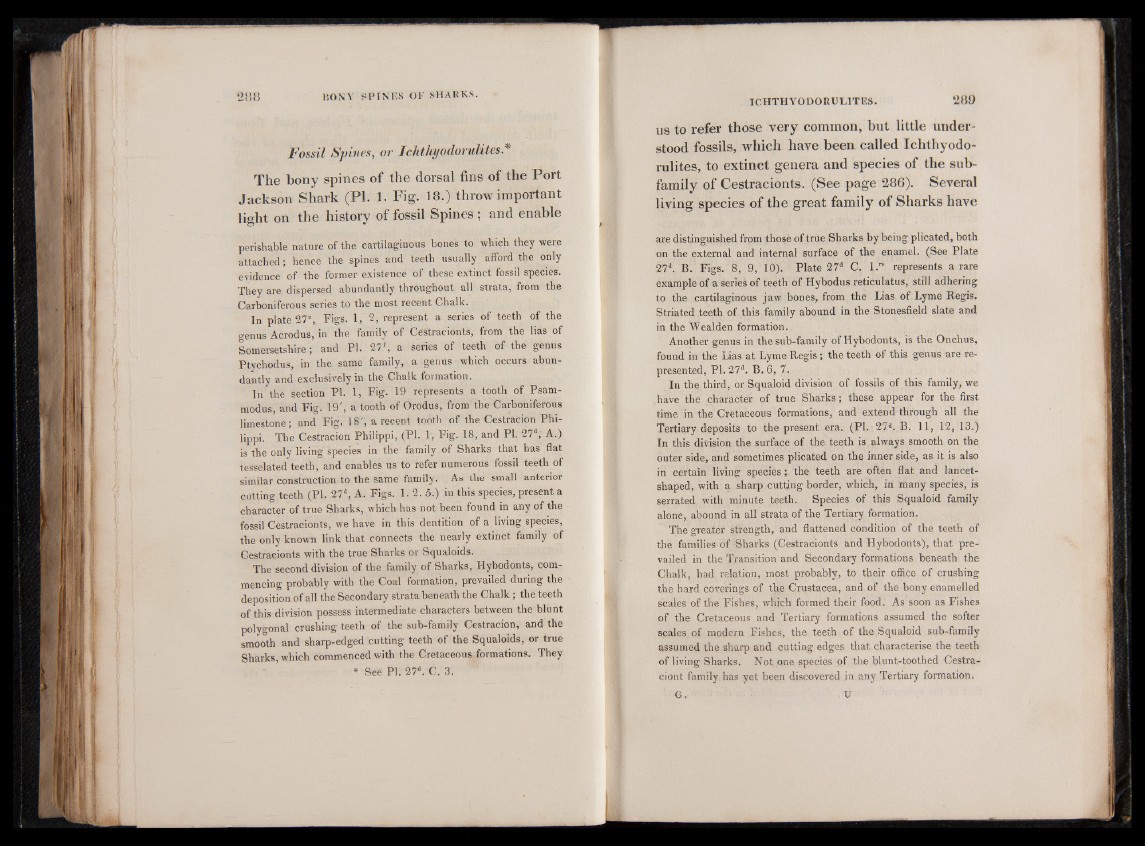
Fossil Spines, or Ichthyodorulites.*
The bony spines of the dorsal fins of the Port
Jackson Shark (PI. 1. Fig. 18.) throw important
light on the history of fossil Spines; and enable
perishable nature of the cartilaginous bones to which they were
attached; hence the spines and teeth usually afford the only
evidence of the former existence of these extinct fossil species.
They are dispersed abundantly throughout all strata, from the
Carboniferous series to the most recent Chalk.
In plate 27% Figs. 1, 2, represent a series of teeth of the
genus Acrodus, in the family of Cestracionts, from the lias of
Somersetshire; and PI. 27f, a series of teeth of the genus
Ptychodus, in the same family, a genus which occurs abundantly
and exclusively in the Chalk formation.
In the section PI. 1, Fig. 19 represents a tooth of Psam-
modus, and Fig. 19', a tooth of Orodus, from the Carboniferous
limestone; and Fig. 18*, a recent tooth of the Cestiacion Philippi.
The Cestracion Philippi, (PI. 1, Fig. 18, and PI. 27a, A.)
is the only living species in the family of Sharks that has flat
tesselated teeth, and enables us to refer numerous fossil teeth of
similar construction to the same family. As the small anterior
cutting teeth (PI. 27a, A. Figs. 1. 2. 5.) iu this species, present a
character of true Sharks, which has not been found in any of the
fossil Cestracionts, we have in this dentition of a living species,
the only known link that connects the nearly extinct family of
Cestracionts with the true Sharks or Squaloids.
The second division of the family of Sharks, Hybodonts, commencing
probably with the Coal formation, prevailed during the
deposition of all the Secondary strata beneath the Chalk ; the teeth
of this division possess intermediate characters between the blunt
polygonal crushing teeth of the sub-family Cestracion, and the
smooth and sharp-edged cutting teeth of the Squaloids, or true
Sharks, which commenced with the Cretaceous formations. They
* See PI. 27a. C. 3.
us to refer those very common, but little understood
fossils, which have been called Ichthyodorulites,
to extinct genera and species of the subfamily
of Cestracionts. (See page 286). Several
living species of the great family of Sharks have
are distinguished from those of true Sharks by being plicated, both
on the external and internal surface of the enamel. (See Plate
27a. B. Figs. 8, 9, 10). Plate 27a C. l . re represents a rare
example of a series of teeth of Hybodus reticulatus, still adhering
to the cartilaginous jaw bones, from the Lias of Lyme Regis.
Striated teeth of this family abound in the Stonesfield slate and
in the Wealden formation.
Another genus in the sub-family of Hybodonts, is the Onchus,
found in the Lias at Lyme Regis ; the teeth of this genus are represented,
PI. 27d. B. 6, 7.
In the third, or Squaloid division of fossils of this family, we
have the character of true Sharks ; these appear for the first
time in the Cretaceous formations, and extend through all the
Tertiary deposits to the present era. (PI. 27d. B. 11, 12, 13.)
In this division the surface of the teeth is always smooth on the
outer side, and sometimes plicated on the inner side, as it is also
in certain living species ; the teeth are often flat and lancet-
shaped, with a sharp cutting border, which, in many species, is
serrated with minute teeth. Species of this Squaloid family
alone, abound in all strata of the Tertiary formation.
The greater strength, and flattened condition of the teeth of
the families of Sharks (Cestracionts and Hybodonts), that prevailed
in the Transition and Secondary formations beneath the
Chalk, had relation, most probably, to their office of crushing
the hard coverings of the Crustacea, and of the bony enamelled
scales of the Fishes, which formed their food. As soon as Fishes
of the Cretaceous and Tertiary formations assumed the softer
scales of modern Fishes, the teeth of the Squaloid sub-family
assumed the sharp and cutting edges that characterise the teeth
of living Sharks. Not one species of the blunt-toothed Cestra-
ciont family has yet been discovered in any Tertiary formation.
G • u